-
RESEARCH01-01-2018
Adherence of hypertension patients in the Brazil’s Family Health Strategy
Revista Brasileira de Enfermagem. 2018;71(3):1030-1037
Abstract
RESEARCHAdherence of hypertension patients in the Brazil’s Family Health Strategy
Revista Brasileira de Enfermagem. 2018;71(3):1030-1037
DOI 10.1590/0034-7167-2017-0297
Views0See moreABSTRACT
Objective:
to evaluate the adherence and associate it to blood pressure control and to follow-up observation of people with hypertension in the Brazil’s Family Health Strategy.
Method:
cross-sectional study, conducted with 417 people in treatment of hypertension, living in a municipality located in the Northwest region of the state of Paraná, Brazil. The data were collected in the first 2016 semester, using an instrument adapted and validated for the evaluation of satisfaction with the services offered by Primary Health Care. Analysis of variance and the logistic regression model were used for the treatment of variables.
Results:
it was evidenced that people with inadequate follow-up observation evaluate the relations between professional/user and the guidance to the medications used as unsatisfactory.
Conclusion:
weak guidelines and ineffective dialogue between health professionals and users might result in an inadequate follow-up observation of blood pressure control and of people with hypertension.
-
RESEARCH01-01-2018
Prevalence and factors associated with experience of intrafamilial violence by teenagers in school
Revista Brasileira de Enfermagem. 2018;71(3):1022-1029
Abstract
RESEARCHPrevalence and factors associated with experience of intrafamilial violence by teenagers in school
Revista Brasileira de Enfermagem. 2018;71(3):1022-1029
DOI 10.1590/0034-7167-2016-0546
Views0See moreABSTRACT
Objective:
To estimate prevalence of intrafamilial violence experience and its association with sociodemographic, sexual and use of alcohol/drugs variables in teenagers of a public school in Salvador, Bahia, Brazil.
Method:
Cross-sectional study with 239 teenagers. Data were collected through structured instrument, analyzed according to descriptive and inferential statistics, with multiple logistic regression.
Results:
Research pointed out a high prevalence of intrafamilial violence among teenagers (60.67%). Experience of this grievance was associated, with statistical significance, with the variables: higher age range (PR = 1.83 and 95%CI: 1.05 – 3.18) and regular use of condom (PR = 1.81 and 95%CI: 1.06 – 3.08). Violence was also associated with consumption of alcohol and marijuana.
Conclusion:
Regular use of condom and consumption of alcohol and/or marijuana represent risk behaviors to the experience of intrafamilial violence by teenagers in school, especially older than 15 years old.
-
RESEARCH01-01-2018
Persistent metabolic syndrome and risk of cardiovascular disease in children and adolescents
Revista Brasileira de Enfermagem. 2018;71(3):1013-1021
Abstract
RESEARCHPersistent metabolic syndrome and risk of cardiovascular disease in children and adolescents
Revista Brasileira de Enfermagem. 2018;71(3):1013-1021
DOI 10.1590/0034-7167-2016-0564
Views0See moreABSTRACT
Objective:
to verify persistence of metabolic syndrome (MetS) and components in overweight children and adolescents, as well as its relation to socioeconomic and demographic characteristics and to the Pathobiological Determinants of Atherosclerosis in Youth (PDAY) score.
Method:
a two-point longitudinal study: at enrollment and after a 24-month interval, with 133 individuals ages from two to 18 years. The demographic anthropomorphic and blood variables were evaluated. Analysis was carried out by simple and paired association tests, as well as multiple logistic regression.
Results:
persistent MetS was observed in 38.3% of the sample, associated cardiovascular risk (ACR) in 79.7%, reduction in arterial pressure and do HDL-c. After adjusting for age and sex, excess weight (ExpB: 0.182; CI: 0.059-0.561), low HDL-c (ExpB: 9.247; CI: 1.157-73.930) and high LDL-c (ExpB:1.915; CI: 0.921-3.979) were associated with persistent MetS.
Conclusion:
persistent MetS was associated with obesity, HDL-c and LDL-c, but not with the PDAY score.
-
01-01-2018
Nutritional status and factors associated with non-institutionalized people over 75 years of age
Revista Brasileira de Enfermagem. 2018;71(3):1007-1012
Abstract
Nutritional status and factors associated with non-institutionalized people over 75 years of age
Revista Brasileira de Enfermagem. 2018;71(3):1007-1012
DOI 10.1590/0034-7167-2017-0207
Views0See moreABSTRACT
Objective:
to determine the factors related to the risk of malnutrition in a non-institutionalized population over 75 years of age.
Method:
a cross-sectional study was conducted using a questionnaire in a sample of 326 individuals over 75 years of age in Castellón (Spain), during 2015, and selected through intentional sampling.
Results:
Malnutrition prevalence was 2.8%. 26.9% of the individuals were at risk of malnutrition, whereas women presented a higher rate (31.5%). Women with a good overall health status showed a lower rate than men, 55% and 69%, respectively. Individuals that showed a lower risk of malnutrition are those with a positive perception than those who have a good overall health. Frail elderly people showed a higher risk of malnutrition (57.5%) compared to non-frail subjects (20.2%) p< 0.001.
Conclusion:
Frail women, self-assessed health, overall health, and use of health care services (nursing consultation) were related to a higher risk of malnutrition.
-
01-01-2018
Estado nutricional y factores asociados en mayores de 75 años no institucionalizados
Revista Brasileira de Enfermagem. 2018;71(3):1007-1012
Abstract
Estado nutricional y factores asociados en mayores de 75 años no institucionalizados
Revista Brasileira de Enfermagem. 2018;71(3):1007-1012
DOI 10.1590/0034-7167-2017-0207
Views1See moreRESUMEN
Objetivo:
determinar los factores relacionados con el riesgo de desnutrición en la población de mayores de 75años no institucionalizada.
Método:
estudio transversal realizado mediante cuestionario en una muestra de 326 individuos mayores de 75 en Castellón (España), durante 2015. Seleccionados mediante muestreo intencionado.
Resultados:
Prevalencia de desnutrición 2,8%. El 26,9% de los individuos están en riesgo de desnutrición, las mujeres lo presentan en mayor proporción (31,5%). Las mujeres presentan una salud general buena en menor proporción que los hombres, el 55% frente a 69%. Tienen menor riesgo de desnutrición los individuos que tienen una percepción positiva y los que tienen una buena salud general. Los mayores frágiles presentan un mayor riesgo de desnutrición (57,5%) frente a los no frágiles (20,2%) p< 0.001.
Conclusión:
Se relacionan con mayor riesgo de desnutrición, mujeres fragilidad, percepción de la salud, salud global y utilización de Servicios sanitarios (consulta de la enfermería).
-
RESEARCH01-01-2018
Empowerment of the mothers of children in a pediatric intensive care unit
Revista Brasileira de Enfermagem. 2018;71(3):998-1006
Abstract
RESEARCHEmpowerment of the mothers of children in a pediatric intensive care unit
Revista Brasileira de Enfermagem. 2018;71(3):998-1006
DOI 10.1590/0034-7167-2016-0689
Views0See moreABSTRACT
Objective:
to analyze the process of empowerment of the mothers of children hospitalized in a pediatric intensive care unit (PICU) according to Cheryl H. Gibson’s framework.
Method:
a qualitative study with a non-directive interview in groups was carried out with 14 mothers in the PICU of a pediatric teaching hospital in the state of Rio de Janeiro, whose data were submitted to thematic analysis.
Results:
all mothers underwent at least one phase of the process of empowerment. Some of them achieved the phase of participatory competence in the care for their children, being heard by the team and expressing their needs, opinions, and questions.
Final considerations:
attentive listening and information sharing with mothers is necessary, in order to provide essential support so that they undergo the process of empowerment, thus involving themselves in care and decision-making regarding their children.
-
RESEARCH01-01-2018
Translation and adaptation of a questionnaire on the needs of postpartum adolescents
Revista Brasileira de Enfermagem. 2018;71(3):992-997
Abstract
RESEARCHTranslation and adaptation of a questionnaire on the needs of postpartum adolescents
Revista Brasileira de Enfermagem. 2018;71(3):992-997
DOI 10.1590/0034-7167-2017-0021
Views0See moreABSTRACT
Objective:
Describe the processes of translation to the Portuguese language and cultural adaptation of the Postpartum Learning Needs (PLN) to the Portuguese context.
Method:
Methodological study of an instrument that was constructed and validated in Jordan. Here are presented the procedures referring to linguistic, semantic and cultural validation, involving the stages of translation from English to European Portuguese, synthesis of translations, back-translation to the original language, expert committee, and pre-testing.
Results:
In the translation process, some vocabulary variations were solved through consensus among translators. The expert committee found that the version translated to Portuguese presented semantic, idiomatic, cultural and conceptual equivalence, while needing some adjustments. Pre-testing was applied to 45 adolescent mothers, of whom 86.6% considered the items comprehensible.
Conclusion:
Semantic, idiomatic, cultural and conceptual equivalences were conceptually satisfactory among questionnaire versions, which is relevant for the Portuguese culture and easily understandable. It is crucial to assess the psychometric properties of the questionnaire so its adapted version can be made available.
-
RESEARCH01-01-2018
Cross-cultural adaptation of the instrument Readiness for Hospital Discharge Scale – Adult Form
Revista Brasileira de Enfermagem. 2018;71(3):983-991
Abstract
RESEARCHCross-cultural adaptation of the instrument Readiness for Hospital Discharge Scale – Adult Form
Revista Brasileira de Enfermagem. 2018;71(3):983-991
DOI 10.1590/0034-7167-2017-0241
Views0See moreABSTRACT
Objective:
to perform the cross-cultural adaptation of the Readiness for Hospital Discharge Scale – (RHDS) Adult Form for use in Brazil.
Method:
a methodological study was conducted in 2015, in Brazil’s federal capital, following the eight stages scientifically established.
Results:
analysis proved the maintenance of semantic, idiomatic, cultural, and conceptual equivalences and kept both the face and content validity of the original version. The judging committee and the pre-test participants declared they understood the RHDS items and answer scale.
Conclusion:
the instrument is culturally adapted for Brazil and can be used as one of the stages for planning hospital discharge.
-
EXPERIENCE REPORT01-01-2018
Clinical and epidemiological teaching of dengue through simulated practice
Revista Brasileira de Enfermagem. 2018;71(2):451-456
Abstract
EXPERIENCE REPORTClinical and epidemiological teaching of dengue through simulated practice
Revista Brasileira de Enfermagem. 2018;71(2):451-456
DOI 10.1590/0034-7167-2016-0503
Views2See moreABSTRACT
Objective:
to describe the experience of clinical teaching on dengue and the practice of epidemiological surveillance using problematization methodology.
Method:
report of experience on educational activity with undergraduate nursing students, held in March 2016, at a public university in the city of São Paulo, conceived in four stages: dialogic lecture, active search of Aedes aegypti, case study and simulation of nursing consultation to individuals with dengue.
Results:
The activity allowed to retrieve previous knowledge about the disease, respond to exercises that addressed different clinical situations and epidemiological surveillance, including in situ evaluation of possible mosquito outbreaks, and discuss the need to expand prevention and health of the individual and the community, the impact of the media in the dissemination of cases and the coping difficulties experienced in the different levels of attention.
Conclusion:
the methodology adopted enabled qualified training of students to cope with dengue.

-
ORIGINAL ARTICLE07-18-2022
Beliefs, knowledge, actions of nursing techniques in breastfeeding in pain management in immunization
Revista Brasileira de Enfermagem. 2022;75(6):e20210546
Abstract
ORIGINAL ARTICLEBeliefs, knowledge, actions of nursing techniques in breastfeeding in pain management in immunization
Revista Brasileira de Enfermagem. 2022;75(6):e20210546
DOI 10.1590/0034-7167-2021-0546
Views1See moreABSTRACT
Objective:
Understand the beliefs, knowledge, and actions of nursing technicians on breastfeeding as a form of non-pharmacological intervention to relieve pain in newborns and infants during immunization.
Methods:
Qualitative study carried out through semi-structured interviews with nine nursing technicians from three Basic Health Units in a city in the state of São Paulo. The theoretical approach of the Belief Model and the methodological framework of Thematic Analysis supported this study.
Results:
Three themes originated: Beliefs, Knowledge, and Actions of nursing technicians.
Final considerations:
Despite knowledge about the benefits of breastfeeding as the most effective method for relieving pain in newborns and infants during vaccination, their restrictive beliefs overrode the evidence, leading them to act in ways that discourage or prevent the mother from breastfeed during vaccination. Formal training is recommended to align with current evidence-based practices.
-
REVIEW12-08-2023
Educational technologies for accident prevention due to falls in childhood: a scoping review
Revista Brasileira de Enfermagem. 2023;76:e20220807
Abstract
REVIEWEducational technologies for accident prevention due to falls in childhood: a scoping review
Revista Brasileira de Enfermagem. 2023;76:e20220807
DOI 10.1590/0034-7167-2022-0807
Views2See moreABSTRACT
Objectives:
to map evidence on educational technology use for accident prevention due to falls in childhood.
Methods:
a scoping review, carried out in October and November 2022, in the MEDLINE, Web of Science, BDENF and CINAHL databases and LILACS bibliographic index. There was no delimitation of language or time. Data were extracted and analyzed descriptively by two independent researchers. The research protocol was registered in the Open Science Framework.
Results:
twenty-six studies were selected. Booklets, pamphlets and leaflets were the most used technologies, presenting health services as the most frequent environment to develop research on fall prevention. The technologies developed were important outcomes: increased knowledge of children, family members, caregivers, health and education professionals.
Conclusions:
educational technology use makes it possible to increase knowledge, adopt safe practices and reduce falls.

-
REVIEW03-15-2024
Resources for health literacy among caregivers of prematurely born children: a scoping review
Revista Brasileira de Enfermagem. 2024;77(1):e20230062
Abstract
REVIEWResources for health literacy among caregivers of prematurely born children: a scoping review
Revista Brasileira de Enfermagem. 2024;77(1):e20230062
DOI 10.1590/0034-7167-2023-0062
Views1See moreABSTRACT
Objectives:
to map the available evidence on resources used to promote health literacy among caregivers of prematurely born children during outpatient follow-up.
Methods:
the Joanna Briggs Institute’s scope review protocol was utilized. The search encompassed six databases, incorporating studies from 2012 to 2022.
Results:
the three included publications revealed that the resources employed are: mobile applications, phone calls, individual counseling, videos, educational pamphlets, and group discussions. Implementing an education protocol during the transition home enhances scientifically grounded health promotion rates.
Conclusions:
there is limited literature addressing the health literacy of these caregivers. The nursing team plays a crucial role in health education and in developing resources applicable to these families.

-
ORIGINAL ARTICLE01-13-2024
Social representations of oncologic surgery for patients with cancer
Revista Brasileira de Enfermagem. 2024;77(6):e20230273
Abstract
ORIGINAL ARTICLESocial representations of oncologic surgery for patients with cancer
Revista Brasileira de Enfermagem. 2024;77(6):e20230273
DOI 10.1590/0034-7167-2023-0273
Views2See moreABSTRACT
Objectives:
to analyze the social representations of patients with cancer regarding oncologic surgery.
Methods:
a qualitative study based on Social Representation Theory was conducted with 126 participants between October 2021 and May 2022 in a public hospital in Rio de Janeiro. A characterization questionnaire, free evocations of the inducing term “surgery”, and semi-structured interviews with 60 participants were applied. Data were analyzed using Microsoft Excel® and IRaMuTeQ.
Results:
the central core of the representation is composed of fear, cure, hope, and removing the disease. The analysis of interviews resulted in six classes that highlight the social changes caused by treatment as well as the need for a support network to cope with the surgical process.
Final Considerations:
the representations reflect fear and hope towards the procedure and the desire to remove the disease, thus translating the cure through surgery.

-
ORIGINAL ARTICLE01-13-2024
Nurses’ perspectives on the use of telemonitoring in the management of people with diabetes and hypertension
Revista Brasileira de Enfermagem. 2024;77(6):e20230481
Abstract
ORIGINAL ARTICLENurses’ perspectives on the use of telemonitoring in the management of people with diabetes and hypertension
Revista Brasileira de Enfermagem. 2024;77(6):e20230481
DOI 10.1590/0034-7167-2023-0481
Views3See moreABSTRACT
Objectives:
to understand the perspective of nurses on the use of telemonitoring in the management of people with type 2 diabetes mellitus and arterial hypertension in primary care.
Methods:
this qualitative research involved sixteen nurses from eight municipalities in Paraná. Data were collected between November 2022 and January 2023 through inperson or remote interviews, which were audio-recorded and subjected to content analysis.
Results:
according to the nurses, telemonitoring enhances users’ knowledge about these conditions, communication and connection with the team, and productivity. However, the lack of electronic resources and equipment, high staff turnover, low user adherence, and the limited availability of professional time present significant challenges.
Final Considerations:
the effective implementation and operation of telemonitoring in the management of people with diabetes and hypertension involve both potential benefits and barriers. It is essential to have the availability of human and technological resources, managerial support, and the commitment of professionals and users.
-
ERRATUM01-13-2024
ERRATUM
Revista Brasileira de Enfermagem. 2024;77(6):e2024n6e08
Abstract
ERRATUMERRATUM
Revista Brasileira de Enfermagem. 2024;77(6):e2024n6e08
DOI 10.1590/0034-7167.20247706e08
Views2In the article “Brazilian nursing specific situation, middle and micro-range theories: a bibliometric study”, with DOI number: , published in Revista Brasileira de Enfermagem, 2024;77(4):e20230520, Chart 1:Where it read:[…]See more -
ORIGINAL ARTICLE09-29-2022
Palliative care production for health professionals in the context of home care
Revista Brasileira de Enfermagem. 2022;75(1):e20210030
Abstract
ORIGINAL ARTICLEPalliative care production for health professionals in the context of home care
Revista Brasileira de Enfermagem. 2022;75(1):e20210030
DOI 10.1590/0034-7167-2021-0030
Views1See moreABSTRACT
Objectives:
to analyze palliative care production developed by health professionals to home care patients.
Methods:
this is an exploratory study, with a qualitative approach, using the transpersonal care theoretical framework. Thirteen interviews were conducted with health professionals and 18 observations were conducted on different cases. Content analysis was performed using MAXQDA©.
Results:
actions performed: maintenance and follow-up measures to people eligible for palliative care, in acts of dialogue and “listening” to caregivers and users, conducting guidelines for the care and self-care process, performing technical procedures, delivery of materials, referrals and medical prescriptions to users.
Final Considerations:
it is perceived the need for advances in the implementation of government policies in Brazil that insert palliative care into the Health Care Network through educational, managerial and care actions that ensure human dignity, thus allowing the development of these and other palliative care interventions.
-
REVIEW06-01-2020
Access of the black population to health services: integrative review
Revista Brasileira de Enfermagem. 2020;73(4):e20180834
Abstract
REVIEWAccess of the black population to health services: integrative review
Revista Brasileira de Enfermagem. 2020;73(4):e20180834
DOI 10.1590/0034-7167-2018-0834
Views1See moreABSTRACT
Objectives:
demonstrate and discuss how the black population’s access to health services occurs
Methods:
integrative literature review with the following question: How does the black population’s access to health services occur? The search was carried out in the Scholar, LILACS and SciELO databases and used the descriptor “access to health services” and the term “population,” resulting in a sample with twelve articles.
Results:
studies show that the difficulty of access is a fundamental factor for the quality of life of people, directly compromising preventive services, especially for women’s health and, in addition, it has significant impact on the illness process of the black population within its particularities.
Final Considerations:
several limiting factors compromise the black population’s access to health services, including institutional and structural factors

-
REVIEW11-06-2020
Transitional care to caregivers of dependent older people: an integrative literature review
Revista Brasileira de Enfermagem. 2020;73:e20200394
Abstract
REVIEWTransitional care to caregivers of dependent older people: an integrative literature review
Revista Brasileira de Enfermagem. 2020;73:e20200394
DOI 10.1590/0034-7167-2020-0394
Views1See moreABSTRACT
Objective:
To identify the needs of caregivers of dependent older people related to self-care in the transition from hospital to home.
Methods:
Integrative literature review that followed a predefined protocol, carried out from March to May 2019 in the platforms EBSCO, B-On, Scopus, Web of Science, and Joanna Briggs Institute. Descriptors and eligibility criteria were defined for the bibliographic sample, which was ten articles. The search was limited to articles published between 2015 and 2019 to guarantee evidence topicality.
Results:
The needs of caregivers related to transitional care can be grouped into five categories: needs in the transition into the role of caregiver; needs related to self-care of caregivers themselves; health needs; economic needs; and social and collective needs.
Final considerations:
The work developed by nurses regarding transitional care of caregivers must have two focuses: managing care provided to dependent older people and managing the needs of caregivers and the care offered to them.
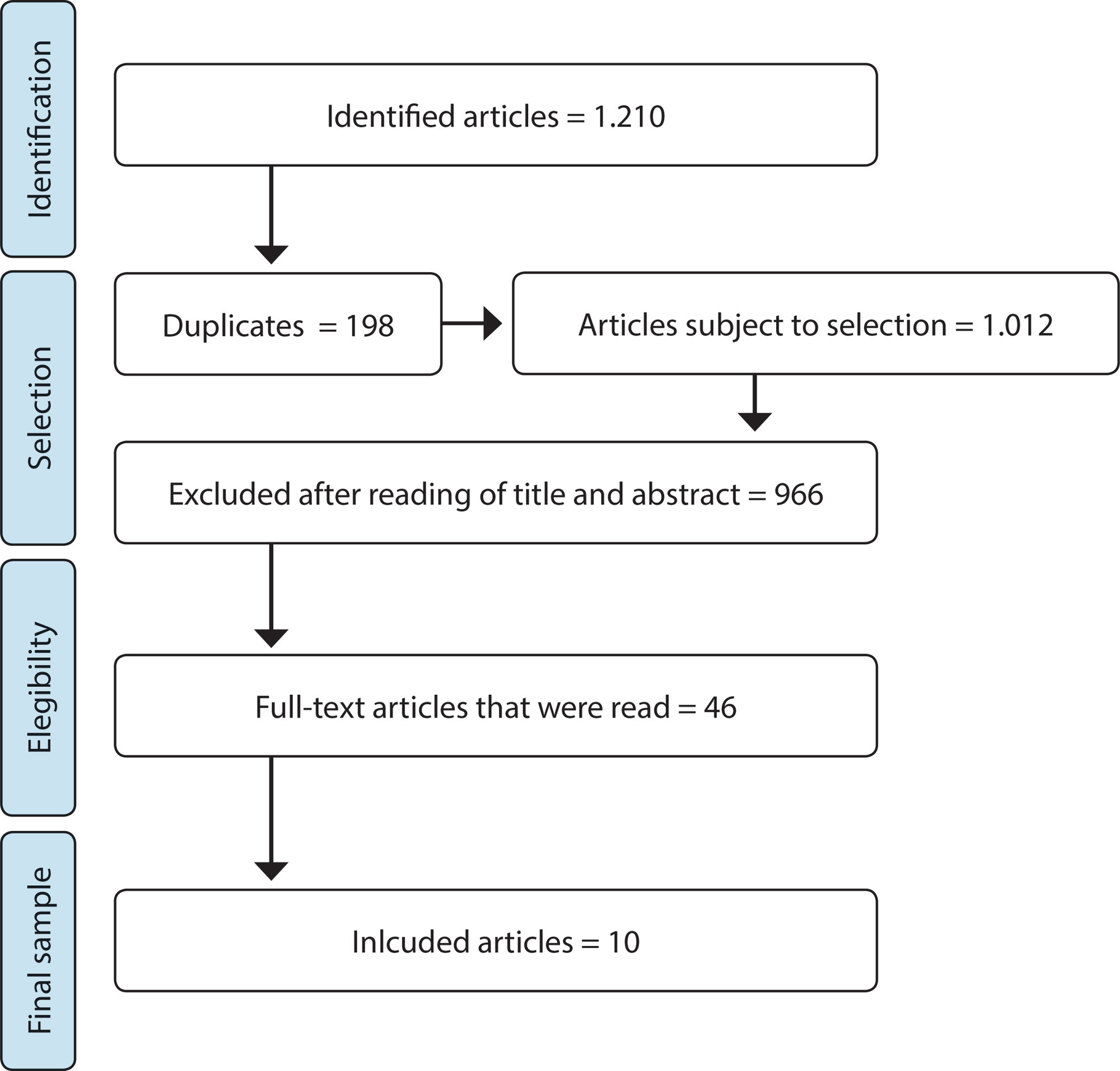
-
REVIEW10-19-2020
Validation methods of nursing protocols: an integrative review
Revista Brasileira de Enfermagem. 2020;73:e20200050
Abstract
REVIEWValidation methods of nursing protocols: an integrative review
Revista Brasileira de Enfermagem. 2020;73:e20200050
DOI 10.1590/0034-7167-2020-0050
Views0See moreABSTRACT
Objective:
to identify scientific production about validation methods of nursing care protocols.
Method:
an integrative review with search at Scielo, Pubmed/MEDLINE, Virtual Health Library, Web of Science, Scopus, and EBSCOhost. The descriptors “validation studies”, “validation studies as topic”, “protocols”, “clinical protocols”, “practice guidelines as topic”, “nursing” and “nursing assessment” and the uncontrolled descriptor “validation” were used.
Results:
thirty-two articles were selected, most of them Brazilian. Content validation by experts was the most frequent method, with no consensus on the number of participants for the process. The collection instruments were mostly created by the authors. Data analysis was performed using descriptive statistics and Content Validity Index, with a variable consensus rate in the analyzed articles.
Conclusion:
protocols validated by experts are robust tools for use in clinical practice, with methodological rigor in development essential for its quality.
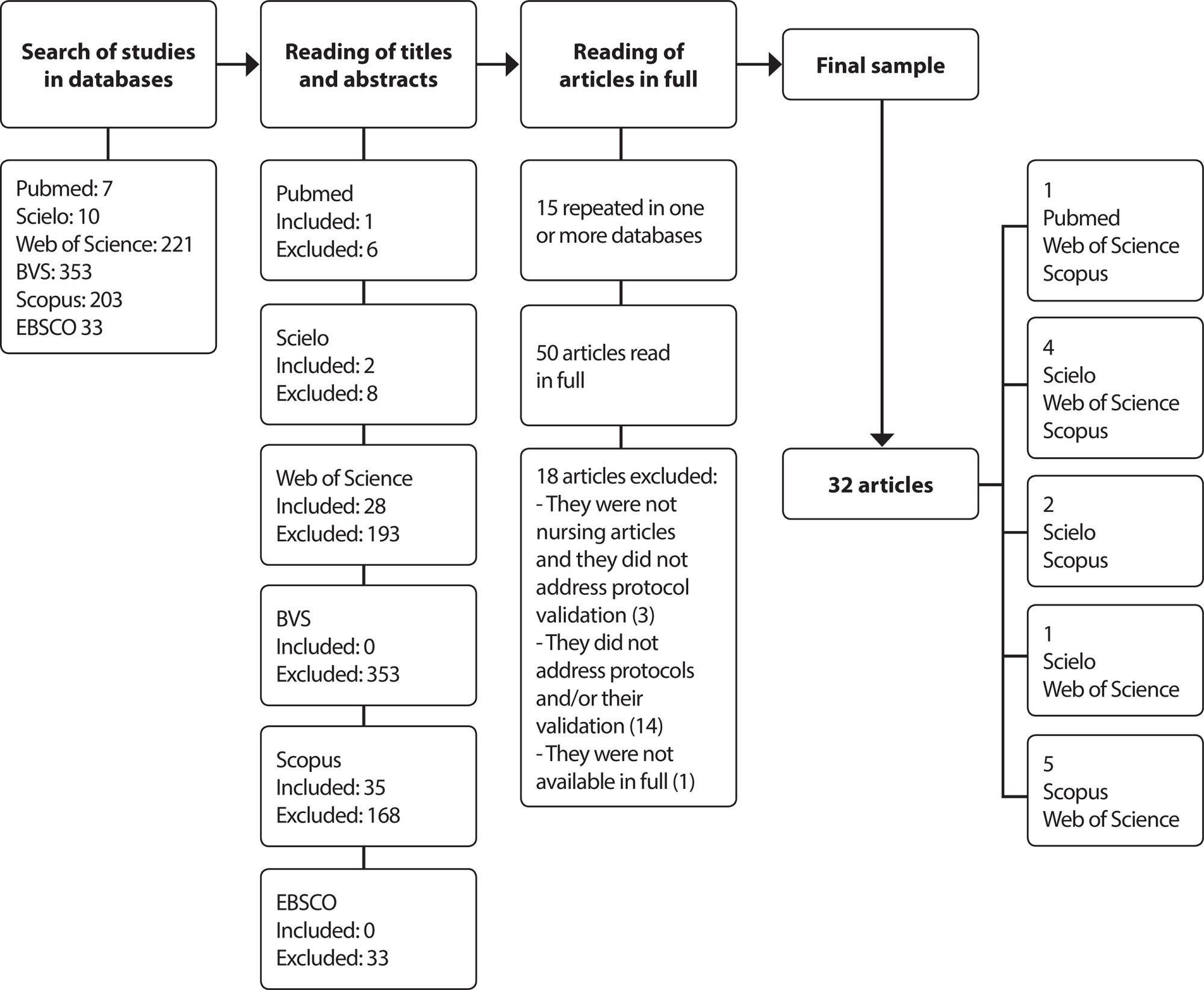
-
ORIGINAL ARTICLE05-24-2021
PEDCARE: validation of a mobile application on diabetic foot self-care
Revista Brasileira de Enfermagem. 2021;74:e20200856
Abstract
ORIGINAL ARTICLEPEDCARE: validation of a mobile application on diabetic foot self-care
Revista Brasileira de Enfermagem. 2021;74:e20200856
DOI 10.1590/0034-7167-2020-0856
Views0See moreABSTRACT
Objective:
to describe the process of validating a multimedia application on a mobile platform to promote foot care for people with diabetes.
Method:
a technological production and methodological type study. Content and appearance were validated by 39 judges (29 nursing judges and ten information and communication technology judges and 15 people from the target audience).
Results:
nursing judges made it possible to validate the material with a total Content Validity Index of 0.95, a non-significant binomial test for most items and Cronbach’s alpha of 0.92, information and communication technology judges with Suitability Assessment of Materials of 99.2% and the target audience with an agreement index of 98%.
Conclusion:
the application proved to be valid and reliable for use in clinical practice as an educational technology to promote foot care for people with diabetes.
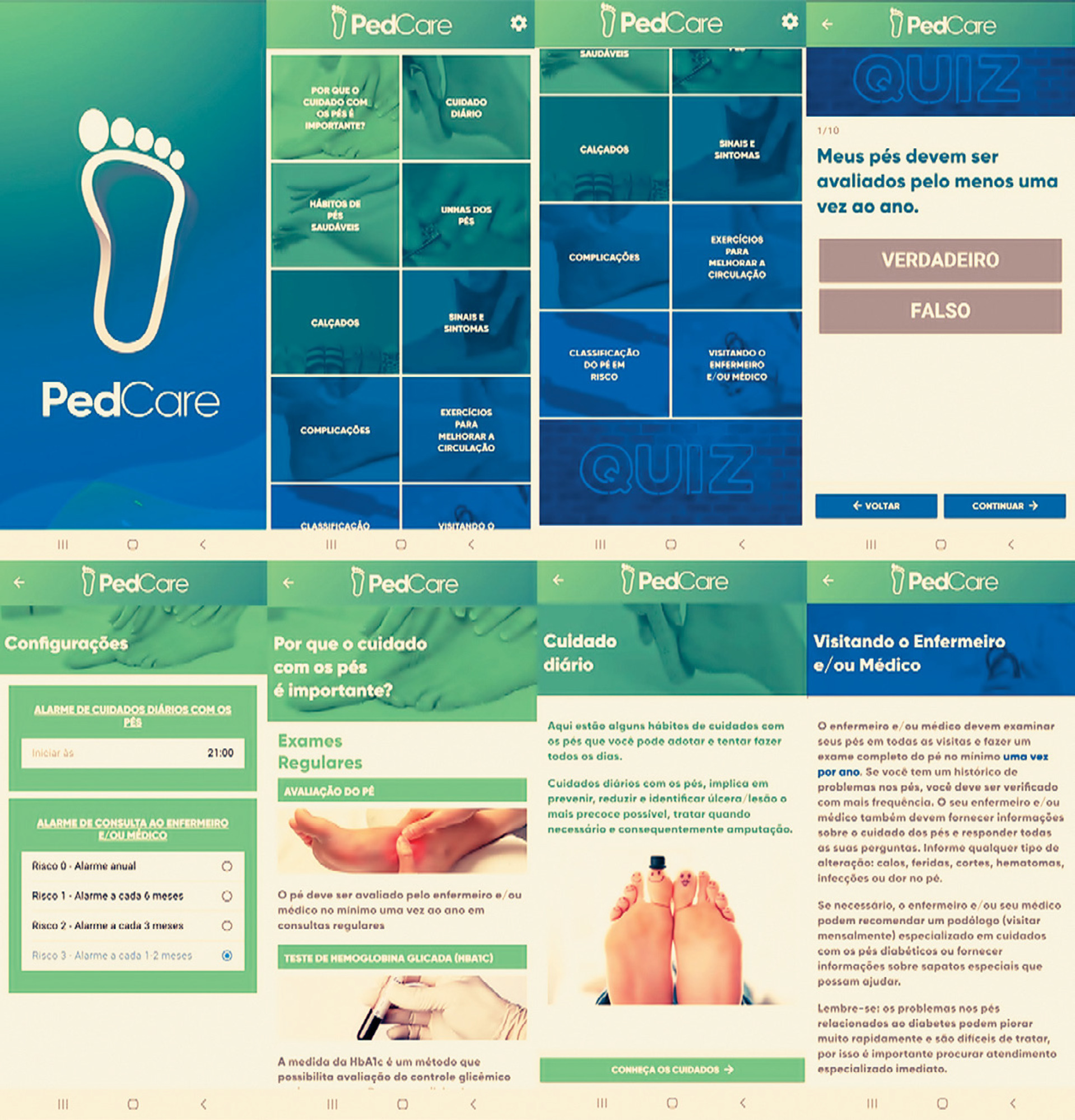
-
EXPERIENCE REPORT04-09-2020
Implementation of an Artificial Intelligence Algorithm for sepsis detection
Revista Brasileira de Enfermagem. 2020;73(3):e20180421
Abstract
EXPERIENCE REPORTImplementation of an Artificial Intelligence Algorithm for sepsis detection
Revista Brasileira de Enfermagem. 2020;73(3):e20180421
DOI 10.1590/0034-7167-2018-0421
Views0See moreABSTRACT
Objectives:
to present the nurses’ experience with technological tools to support the early identification of sepsis.
Methods:
experience report before and after the implementation of artificial intelligence algorithms in the clinical practice of a philanthropic hospital, in the first half of 2018.
Results:
describe the motivation for the creation and use of the algorithm; the role of the nurse in the development and implementation of this technology and its effects on the nursing work process.
Final Considerations:
technological innovations need to contribute to the improvement of professional practices in health. Thus, nurses must recognize their role in all stages of this process, in order to guarantee safe, effective and patient-centered care. In the case presented, the participation of the nurses in the technology incorporation process enables a rapid decision-making in the early identification of sepsis.
-
REVIEW03-24-2021
Development of clinical competence in nursing in simulation: the perspective of Bloom’s taxonomy
Revista Brasileira de Enfermagem. 2021;74(1):e20200135
Abstract
REVIEWDevelopment of clinical competence in nursing in simulation: the perspective of Bloom’s taxonomy
Revista Brasileira de Enfermagem. 2021;74(1):e20200135
DOI 10.1590/0034-7167-2020-0135
Views0See moreABSTRACT
Objectives:
to investigate the scientific evidence on the use of Bloom’s taxonomy for developing competence in nursing professionals and students in clinical simulation.
Methods:
integrative review of the National Library of Medicine (NLM), National Institutes of Health (NIH), Cumulative Index to Nursing and Allied Health Literature (CINAHL), Latin American and Caribbean Literature in Health Sciences (LILACS), Web of Science and SCOPUS databases, using the Rayyan application.
Results:
a total of 871 studies were identified; four composed the sample. The development of clinical competence occurred through the coordination of knowledge, skills, and attitudes. To develop the cognitive domain, the objectives of knowledge and comprehension of the Bloom’s taxonomy were mobilized. The psychomotor domain required development of the skills demanded by the proposed clinical care. The affective domain was developed through will and motivation to learn.
Conclusions:
it is possible to develop clinical competence in nursing by adopting Bloom’s taxonomy in each phase of clinical simulation.
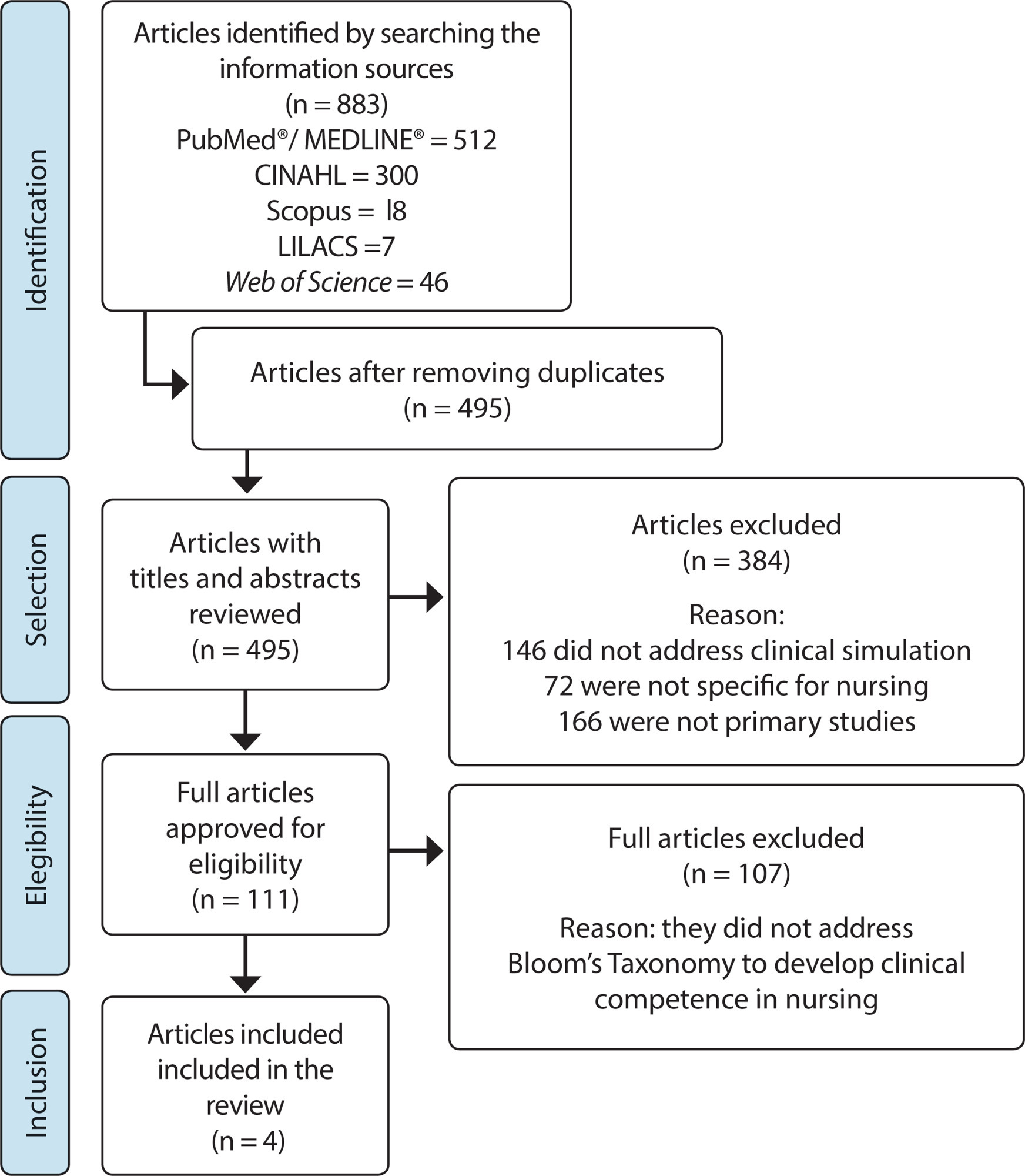
-
03-27-2020
Coronavirus 2020
Revista Brasileira de Enfermagem. 2020;73(2):e2020n2
Abstract
Coronavirus 2020
Revista Brasileira de Enfermagem. 2020;73(2):e2020n2
DOI 10.1590/0034-7167-2020730201
Views0Emerging and reemerging infectious diseases are constant challenges for public health worldwide. Recent cases of pneumonia of unknown cause in Wuhan, China, have led to the discovery of a new type of Coronavirus (2019-nCoV), which are enveloped RNA viruses, commonly found in humans, other mammals and birds, capable of causing respiratory, enteric, hepatic, and neurological […]See more -
ORIGINAL ARTICLE12-13-2019
Accessibility of children with special health needs to the health care network
Revista Brasileira de Enfermagem. 2019;72:65-71
Abstract
ORIGINAL ARTICLEAccessibility of children with special health needs to the health care network
Revista Brasileira de Enfermagem. 2019;72:65-71
DOI 10.1590/0034-7167-2017-0899
Views0See moreABSTRACT
Objective:
To know how children with special health needs access the health care network.
Method:
This is a qualitative research of descriptive-exploratory type, developed using semi-structured interviews mediated by the Talking Map design. Participants were 19 family caregivers of these children in two Brazilian municipalities. Data were submitted to inductive thematic analysis.
Results:
Difficulties were mentioned from the diagnosis moment to the specialized follow-up, something represented by the itinerary of the c hild and his/her family in the search for the definition of the medical diagnosis and the access to a specialized professional; a gap between the children’s needs and the care offered was observed in primary health care.
Conclusion:
The access of children with special health needs is filled with obstacles such as slowness in the process of defining the child’s diagnosis and referral to a specialist. Primary health care services were replaced by care in emergency care units.
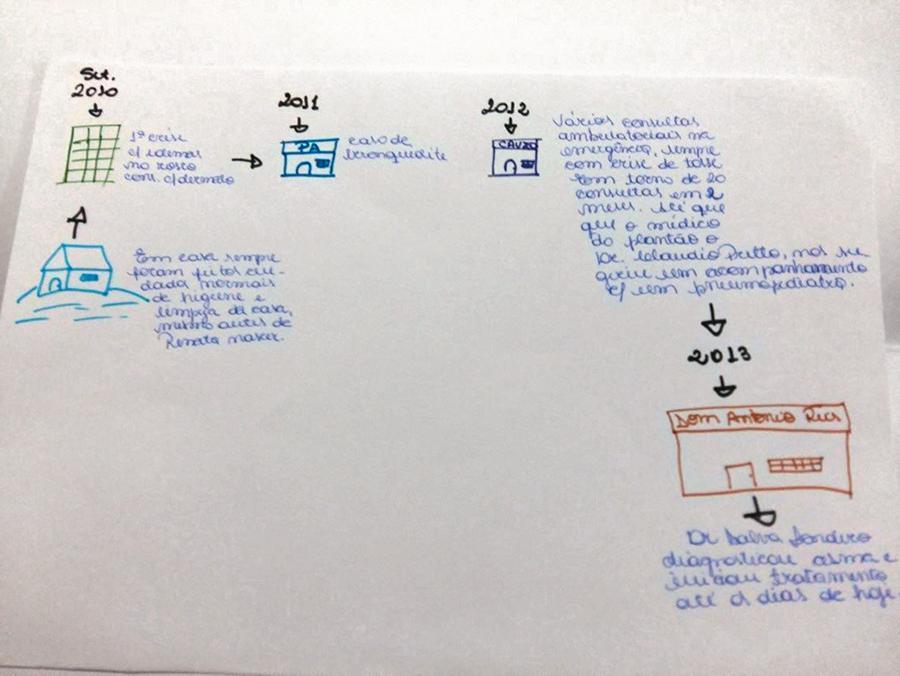
Search
Search in:
Nuvem de Tags
Adolescente (85) Atenção Primária à Saúde (239) COVID-19 (91) Criança (91) Cuidados de Enfermagem (269) Educação em Enfermagem (151) Educação em Saúde (139) Enfermagem (930) Enfermagem Pediátrica (86) Estudantes de Enfermagem (77) Estudos de Validação (131) Família (87) Idoso (208) Promoção da Saúde (99) Qualidade de Vida (104) Saúde do Trabalhador (86) Saúde Mental (145) Saúde Pública (82) Segurança do Paciente (150) Tecnologia Educacional (100)



